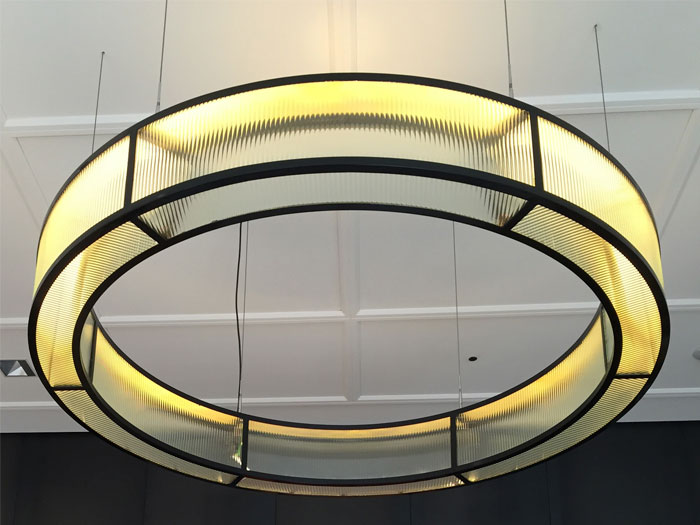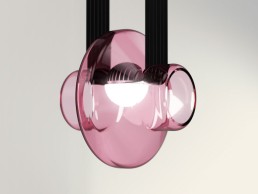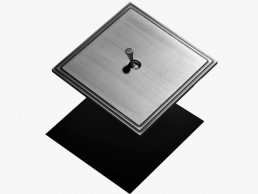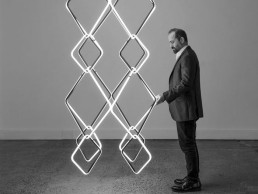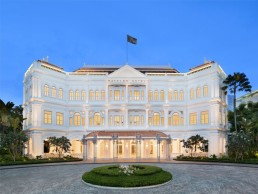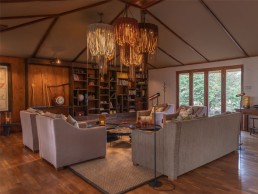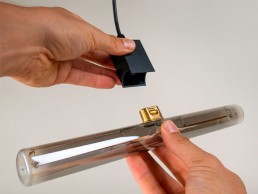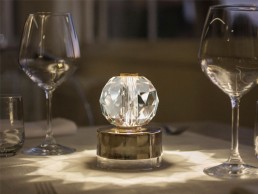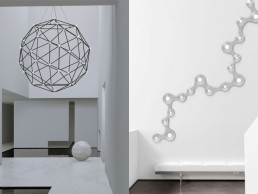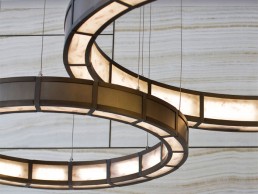Etat-des-Lieux - Studio d'Armes

Designed by Alexandre Joncas and Gildas Le Bars in their Canadian-based Studio d’Armes, Etat-des-Lieux is a playful new product for interior architects and designers that allows them to create an infinite variety of configurations by playing with geometry and tension.
“The intentions behind État-des-Lieux is an unconventional and timeless product that can be used as a tool for designers and architects to convey their own personalised skills and solutions. It had to be a modular system that could be configured and modified to adapt to any space,” explains the design duo.
“Etat-des-Lieux is the only lighting system that we know of to feature a wide, flexible, conductive cable. Elegantly finished in matte black, the cable's flexibility enables the spatial designer to create an infinite variety of configurations by playing with geometry and tension.”
They continue: “The design process started around the idea of a strap that would serve as a conductor but also as the suspension system, which presented in itself many challenges with the extrusion uniformity. The solution laid by pushing the boundaries of process making and by finding just the right amount of tension for the size of the extrusion with our sight set on functionality and aesthetics.”

Each component has been designed and crafted in the studio, with the wide conductive strap at its core. “[The strap] supports the light modules while supplying them with power, but above all, it allows Etat-des-Lieux to be configured according to the demands of any space it inhabits.
“The glass globe, handblown in Québec into a hand-carved mould, is inspired by the scenic mountains and their reflections in nearby waters.”
The globes are available in clear or frosted finishes and in four colours: transparent, pink, grey and amber, and house the light module made of anodised aluminium and frosted glass.
“The light module is totally versatile: light direction, light temperature (from 2700K to 4000K), lumens and dim-to-warm can be configured. The shape of the glass globe was conceived with geometry on a rotating axis following a pulse line, which gives an organic impression of mountains mirrored on a lake. It is with an automated process of working the scientific glass and working closely with local artisans that we found precision solutions. All the components have been designed and tailored to fit one another to create not only a harmonious device but also an efficient assembly line.
“Etat-des-Lieux can be repaired and adapted to another space by easily replacing or adding components as most of it is locally made with durable materials.”

The fixture, taking 20 months to complete its design journey, is an avant-garde and timeless product that, as described by Joncas and Le Bars, is a “polyvalent” light that brings “fascination and innovation” together. “État-des-Lieux really embodies the view we wanted to share by bringing quality of light and where components were individually developed with versatility in mind. Thus, resulting in an almost organically organised assembly giving way to an efficient system allowing all contributors to express their craft throughout the delivery of the end result: a light emitting object fixed in space.”
Alexandre Joncas and Gildas Le Bars set up their design studio in Canada to create enigmatic and modern light structures with a singular poetic approach. Nestled in the lush landscape of Canada’s mountains, d’Armes boasts a tight-knit team of professionals, designers and craftspeople thoughtfully weaving in tandem refined, distinct and timeless designs. Extensive research, fine engineering and experimentation in materiality, tension, light and space deliver illuminated sculptural pieces featuring disparate elements that inspire unique emotional responses.
Edges - Atelier Luxus
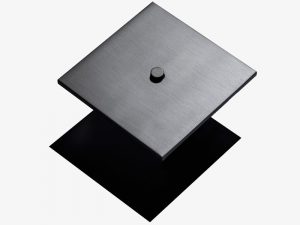
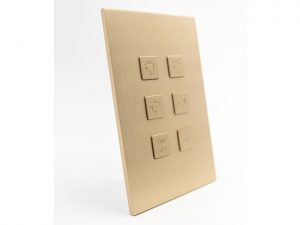
Edges is the most recent collection of switches and sockets presented by Atelier Luxus. Created by Naci Arel, Managing Director of Atelier Luxus, the collection reflects the studio’s passion for bringing high-end, sophisticated products to the market.
Designer Arel has a Master’s degree in Management Sciences from the University of Liège and another Master’s in SME’s strategy and innovation from the University of Maastricht.
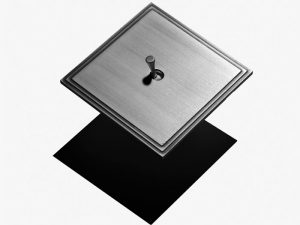
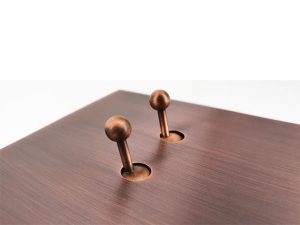
He started his career in the switch and socket field by launching Luxonov in 2009 in collaboration with commercial partners.
Atelier Luxus’ passion for beauty and excellence in the art of living gives life to its products. The studio’s drive is to create objects that are unique in design and exceptional in execution.
With its exquisite details, solid precious metals and shaping, the quality of Edges is expressed in both its aesthetic and feel, bringing an element of luxury to the hand, combining extraordinary craftsmanship with pure design and rich tones.
For the past 25 years, Atelier Luxus has been conceiving designs for electrical devices for some of the most elegant interiors, with the determination to offer extraordinary, superlative and best solutions, and is constantly striving for the perfect balance of forms.
Each Atelier Luxus product is produced from a single sheet of thick, pure brass and offer almost unlimited possibilities of different patinas.
High-precision techniques and micro-machining are used to create the perfect result in assemblage, details in refinement and unicity.
Imagined for luxury hospitality and high-end properties, the Edges collection expresses the emotional and pure aesthetic of a lifestyle rather than the technology they provide.
The UK Design Market
Acting Editor Sarah Cullen sat down with UK-based product designer Michael Anastassiades for an insight into the UK lighting product design industry and how it has evolved during his career.
Starting his career in product design late in the game for a designer, Anastassiades has proven that all you need is determination and passion to be able to create a success story for yourself. “I always wanted to do something creative ever since I was a kid, but if you were to ask me when I finished school, I always wanted to be an artist. But, unfortunately, my family didn’t support that idea because they thought the chances of being a failed artist are much higher than any other profession,” Anastassiades reflects.
“So, I needed to get a job and it was easier to get a job as an engineer than as an artist. I went to engineering school at Imperial College and when I finished my studies I decided that – okay – I got what I needed and now I want to try something else, and that was when I went to the Royal College to study a Master’s in Design; this changed everything for me. I still had a lot of work to do. I was feeling like the odd one out, everyone else on my course had at least four more years of design education.”
It was at this time Anastassiades established his studio in 2007, where he made the decision to pursue design for industry and explore its relationship further.
“Sometimes, when you need to prove something it makes you work harder rather than just simply getting exactly what you want all the time,” he tells darc. “There will be a point where things are so easy in your life that you don’t even have to work hard for them.”
It was also at this time that the UK lighting industry was shifting into a realm of new technology with the phasing out of incandescent lighting and the introduction of LED. “I felt it was a little bit unfair, the timing, having invested so much, it was a little bit too much of a radical sort of move that they discontinued the lamps before they even had any quality replacements. The quality of illumination of what was coming out was really bad and what was actually being killed was the whole poetry of light, in its temperature and its glow, everything about it was really beautiful,” he says. “Companies started becoming more proactive in trying to find a replacement of all these lost qualities. And later on, when I started working with Flos in 2011, I realised that working with a big manufacturer meant that the opportunities to actually produce your own lamp, in the sense of specifying your own LED, was possible to produce in larger quantities. So, I started becoming a little bit more hopeful as to how quickly things could improve.”
When considering styles or themes that may identify the UK design market, Anastassiades determines the fact the region is so multicultural and multi-influenced by a variety of designers from a range of backgrounds is what makes UK design what it is. “British design doesn’t really exist. The fact that there are a lot of international designers that are based in the UK, makes it difficult to pin down what British design is. And, especially in lighting, I think the lighting industry, in terms of designers, is defined by the people that actually produce lighting.
“You could say in places like New York there was a strong lighting scene that existed, in the sense of style of lighting that they were producing. Designers like Lindsey Adelman, Jason Miller Bec Brittain, David Wicks etc. somehow all came out around the same time and were doing very similar things, influencing each other and coming up with a language. It was quite specific that you could label it as New York lighting design. But I don’t think anything similar exists in Britain.”
Looking at current trends in the UK, he identifies brass and spheres as typical recurring elements in designs. “I started using brass 15 years ago in a lot of my fixtures and I remember receiving very negative comments from people back then about why I was using brass - it’s an old-fashioned material. And I said, how can you call a material old fashioned? A material’s a material and there’s beauty in every material - whether it’s chrome, in a sense of its finish, or a brass or another finish, it’s all material. So, the idea of me using brass at the time was because it had this beautiful warmth and the colour was reflecting light in a very beautiful way. But now it seems that all of a sudden, the whole market is full of brass objects, it’s translated into absolutely every single field. It’s interesting how people get influenced and how they change their minds as well, which really surprised me.
“I don’t believe in things being phased out because my whole approach and philosophy in design is about timelessness. The idea of making a material out of fashion or out of trend is irrelevant to me. If you look at all those beautiful plastics and especially in Scandinavia where they use brass a lot and iron mongering, all this stuff is still relevant today and looks incredibly contemporary, even if they were designed or made 60 - 70 years ago.”
When looking at the future of design in the UK, much like most sectors internationally, the market has inevitably been impacted by the Covid-19 pandemic. “The future depends on so many different things. On the economy and the way the world is going – the whole Covid crisis – it’s something that you never could have predicted, so anything can change, but I really believe that people will always have a need for physical things.”
And, like the majority of us, Anastassiades also experienced the sudden jolt of lockdown in the UK and had to make adjustments in his personal and professional life.
“It was challenging I guess, like for everybody. But at the same time, I think quite cathartic. I mean, we had to learn new ways of working, so it was very educational. We have to shed a few fixations that we held in the past about how things needed to be, and we all of a sudden became flexible and more receptive. But we have to adapt and learn new ways of working. As a creative, I always like to make things physically, so in the beginning, I was suffering because being at home and not having the right tools or the space for things was very frustrating.
“But it did make me question a lot of things in terms of my role and the way I do things. I think it naturally raises questions - do we really need so much around us – constantly designing more and more? And I think it even made me feel stronger and more focused about my vision in a sense of the designer really raising those questions.”
Lester Bennett
UK’s Lester Bennett, President of the British Institute of Interior Design (BIID), sits down with Acting Editor Sarah Cullen to discuss the evolution of interior design in the UK, current trends and his work with the BIID to promote UK design to the international community.
Established in 1965, the British Institute of Interior Design is the UK’s only professional institute for interior designers. The Institute sets national professional standards, promotes learning and debate, and champions the value of interior design on the national and international stage.
The organisation was originally founded as the Interior Decorators and Designers Association (IDDA). In 2001, the IDDA was amalgamated with the globally recognised International Interior Design Association UK Chapter (IIDA), to form the British Interior Design Association (BIDA).
The Secretary of State recognised the BIDA as the pre-eminent body in the field in 2009 and granted Institute status, so it became the British Institute of Interior Design. In 2015, the BIID celebrated 50 years as an organisation dedicated to the interior design profession, making it the UK’s oldest professional body representing solely interior designers.
In the UK, the BIID is a full member of the Construction Industry Council and, as such, is part of Government consultations to advise on new policy and legislation. Internationally, the BIID is represented on the board of the International Federation of Interior Architects and Designers.
darc’s Acting Editor, Sarah Cullen, sat down with current BIID President, Lester Bennett, to find out more about the history of the industry and current trends occurring in UK interiors.
Bennett is an independent design consultant with 40 years of design experience. His career has included founding his own practice, working as a design director for a leading residential developer and as a founding partner of Folio Design LLP. Bennett specialises in residential interior architecture and design, whilst also having a wide range of experience in commercial and retail design, industrial, exhibition and product design, with a client list including Mobil, Alliance and Leicester, Celador Productions, Morgan du toi, Elstree Studios, Taylor Walker Breweries, and Handles and Fittings (HAF), with products still in production after nearly 30 years.
Prior to setting up Folio Design LLP, Bennett was Design Director at Westcity Wates/Westcity Developers, delivering prestigious and iconic London residential schemes such as West End Quay, The Phillimores (now Academy Gardens), Pavilion Apartments and Phillimore Square (now Thornwood Gardens). His concept work and his understanding of high end, and often cutting-edge, residential design earned these schemes national and international awards.
In addition to his work in contemporary design, Bennett has studied, and lectured on, the history of the English House and is well versed in period interiors, informing his work on many historic and listed buildings.
Bennett also has a thorough understanding of cabinet making and site construction techniques, materials and processes, and is a passionate flag waver for the art of hand drawing.
Other than the multifaceted aspects of art and design, his passions are his family, music (he is an accomplished jazz drummer) and the countryside.
Bennett previously served on the BIID Professional Practice Committee as Chair, a term on the Membership Committee and for several years as assessor and student mentor. His key objectives as President are to work closely with the BIID Council, committees, and other groups within the design community, nationally and internationally, and to continue to raise the profile of the BIID.
When asked what the evolution of interior design looked like in the UK, Bennett comments: “From the long-term trend of minimalist and modernist interiors with their restrained colours and, at times, slightly sterile and formalised arrangements, the last few years have seen a movement to a more eclectic, layered and colourful approach. Although this is a trend in itself, it is without the direct or tightly channelled constraints of the former; any direction or approach can be followed, allowing a greater degree of expression for both the designer and the client.
“Quirky pieces, one-offs, retro and antique, are mixed with colourful and textured fabrics; this, along with contemporary paintings and sculpture creates a much more personal, relaxed but vibrant and interesting environment.
“Also, there is now much greater concern over sustainability with designers increasingly sourcing materials and craftspeople locally, which often leads to a heightened sense of place and a more eclectic result.”
Looking specifically at the role of lighting in the interiors industry, he comments: “The recent developments in LED in terms of lenses/reflectors, colour rendition, colour temperatures and control systems, have allowed greater flexibility and lower running costs. Architectural LED lighting can be utilised to enhance spaces in a much greater way than ever before for ambient, task and accent lighting, and as a result of the diminishing sizes of the fittings, the light sources are often discreetly hidden. This has led to opportunities for decorative lighting to be just that, decorative. As there is no longer a requirement for these wall or ceiling fixtures to provide ambient light, they can be created to twin with the more eclectic interior schemes to provide exciting statement pieces and light sculptures.”
The latest effort the BIID is working on comes as a result of the long overdue, global conversation about diversity and inclusion in society in 2020. The BIID is keen to engage with the interior design community and better understand the issue specifically in the interior design profession.
There is currently no research into diversity in the UK interior design sector, so the BIID has launched a new survey to gain a detailed picture of the current landscape and drive valuable new insights. The Institute is asking all professional interior designers, junior and senior, employees and practice owners, to complete the ‘Diversity in Interior Design’ survey to help the BIID understand more about the make-up of the profession.
The survey forms an important part of the BIID’s recently launched action plan into diversity and inclusion. The initial plan includes diversity and inclusion specific training content in the BIID Continuing Professional Development (CPD) calendar and the development of an Equality, Diversity and Inclusion (EDI) Strategy, which will lay out specific areas for long term action. This will be included as part of the BIID 2021-2024 Strategic Plan that will be published in March 2021. These initiatives will be overseen by a new BIID Diversity and Inclusion Committee.
Raffles Singapore Hotel, Singapore
The Raffles Singapore Hotel re-opened last year after an extensive refurbishment. The Champalimaud Design interiors and Tino Kwan lighting scheme are a delicate layering of modernity, authenticity and refined beauty bringing the historic site to life.
In August 2019, the famous Raffles hotel in Singapore revealed its extensive renovation. With interiors completed by Champalimaud Design and a new lighting scheme by Tino Kwan, Acting Editor Sarah Cullen sits down with Partner and CEO Ed Bakos of Champalimaud and Lighting Designer Tino Kwan, of Tino Kwan Lighting Consultants, to find out more about the magnificent project.
Raffles Hotel Singapore first opened its doors to guests in 1887, the old bungalow-style building offered 10 rooms to tourists visiting the Far East. It quickly established itself as one of the most notable hotels in the region and the name expanded to opening international destinations in the ensuing years. In 1991, the hotel completed a full restoration that lasted two and a half years, which returned the building to its former glory replicating the elegance of its heydays in 1915.
Holding such national importance and international reputation, special attention was required to ensure the preservation of the original colonial architecture was maintained throughout in its latest refurbishment by Champalimaud Design.
The monumental renovation plans began back in 2013 when Katara Hospitality invited Champalimaud to participate in a design competition for the renovation. “They were looking for a design studio to help them update the iconic property with an elevated and contemporary point of view, while also remaining true to its historic roots,” explains Bakos.
Kwan and his team were introduced to the project in 2014 and worked closely with Ed Bakos and interior designer Jon Kastl, also of Champalimaud, throughout the project: “We were invited by Aedas Singapore to be part of the design team, as the team members of this project required extensive experience in listed and historical buildings. This project took five years to complete from August 2014 to August 2019,” says Kwan.
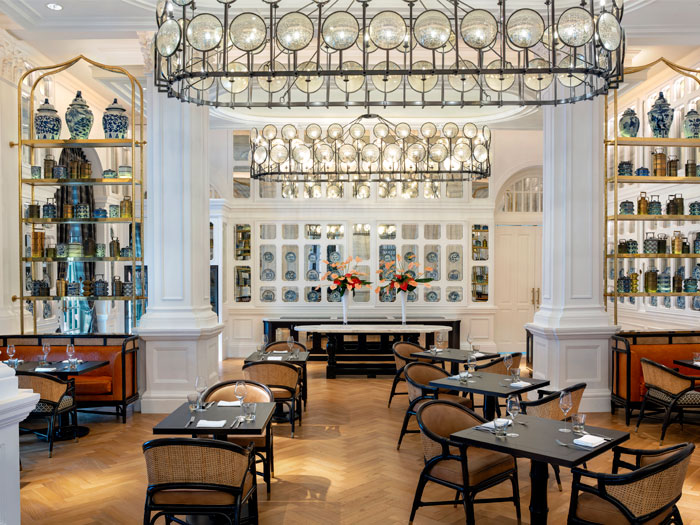
Throughout the hotel, space usage and flow were re-considered in the public areas to increase social engagement and create an ease of flow. With a sensibility that is much more contemporary than its previous design iterations, there was an emphasis on maximising scale through the careful curation of custom furniture in sumptuous shapes, ornate screens, locally sourced heritage antiques, and impactful lighting. The reception area and lobby lounge were transformed into an elegant reception and now serves as a gateway to the hotel’s alluring dining spaces: The Tiffin Room, Writer’s Bar, La Dame de Pic, Long Bar and Butcher’s Block. The colours used throughout this area are composed of the original black and white contrasts juxtaposed with caramel, shades of green, and creamy neutrals. Light floral references and gilded trimming along with a bejewelled chandelier from Preciosa add a layer of refinement to the overall vision.
“The client wanted to maintain its original colonial ambience, tranquil garden setting, classical architecture, and in addition, the new design was required to rejuvenate and inject new life to the hotel,” says Kwan. “We needed to employ the latest lighting technology, equipment and careful consideration to the lighting installation details in order to minimise the impact to the existing structure in order to achieve our design intent.”
Bakos adds: “Decorative lighting was essential - as important as choosing the other design details like the colour palette or finishes. Raffles is such a grand hotel, we knew we needed to use impactful lighting to mould each of the spaces we designed, create a sense of intimacy and to also invoke a feeling within the different spaces depending on what those rooms were used for.
“One of the best examples of how decorative lighting impacted the spaces at Raffles is within the lobby. Our goal with that particular space was to encourage more socialisation. In earlier iterations of Raffles Singapore, the hotel served as a social hub, a place where dignitaries, locals and celebrities would congregate for events, meetings, or to just hang out. We wanted to bring that kind of energy back to the hotel especially in that space,” he adds.
“In some of the most iconic hotels, chandeliers were the centrepiece of such social spaces - they weren’t just jewellery for the ceiling but a way to ground the guests and the location; they were key to creating a sense of place. This is one of the reasons why you’ll find a custom statement Preciosa chandelier in the lobby. We also wanted to create intimate moments within the open plan area. To do that, we used decorative lighting to shape and create additional ‘spaces’.”
Adding to the lobby’s lighting treatment, Kwan explains: “Decorative lights were selected to complement the interior and provide appropriate ambience to each space. The huge chandelier in the main lobby was the signature in the hotel. We worked very closely with the interior designer, manufacturer, and the constructor to ensure the colour temperature and lighting effect were according to our design intent and the motorised chain system for lifting [the chandelier] up and down for maintenance and cleaning was technically sound.”
Concerning the design inspiration of the bespoke piece, Preciosa tells darc: “The main chandelier was inspired by the lotus flower and craftsmanship and technical ingenuity played a big role in ensuring the chandelier is a work of art. Instead of typical tulip-shaped trimmings, the team hand-blew crystal lotus-shaped flowers. There had never been a chandelier in the lobby before, so we had to ensure a relatively lightweight light due to the building’s structure and the fact there is a skylight above it.
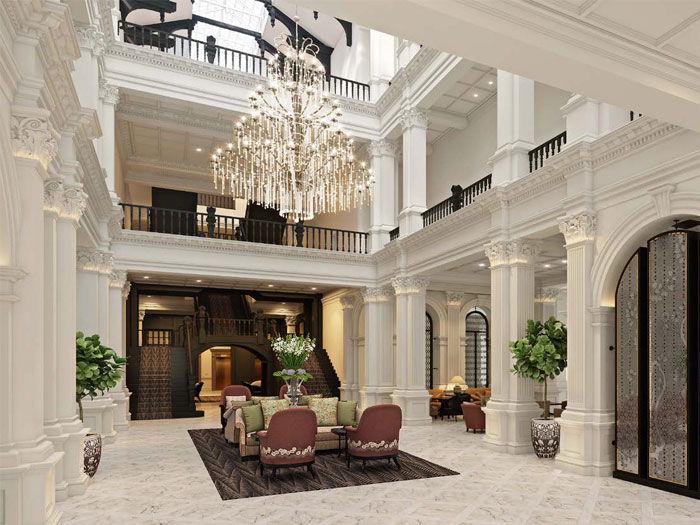
“The nearly four-metre tall and almost five-metre wide chandelier features handblown crystal octagon and almond trimmings in clear and onyx. The vases are handblown crystal with a cut decoration.”
Decorative lighting was also used to full effect in the dining spaces of the hotel. Most notably, La Dame de Pic, the hotel’s signature restaurant, features another custom-designed Preciosa chandelier, featuring polished-brass discs. Surprisingly, the scheme for this restaurant was put together by the Champalimaud team at the 11th hour due to a shift in design direction.
“[In] La Dame de Pic, we used lighting to help create a narrative - in this particular case around the chef Anne-Sophie Pic,” explains Bakos. “For the restaurant we designed a custom chandelier composed of polished brass discs of laser cut spades (La Dame de Pic is a play on ‘Queen of Spades’ in French). We also made complementary wall sconces of similar inspiration as well. Overall the lighting was used to create a soft articulation and to add a subtle drama to the room, complementing the sophistication and refinement of Anne-Sophie’s cuisine.”
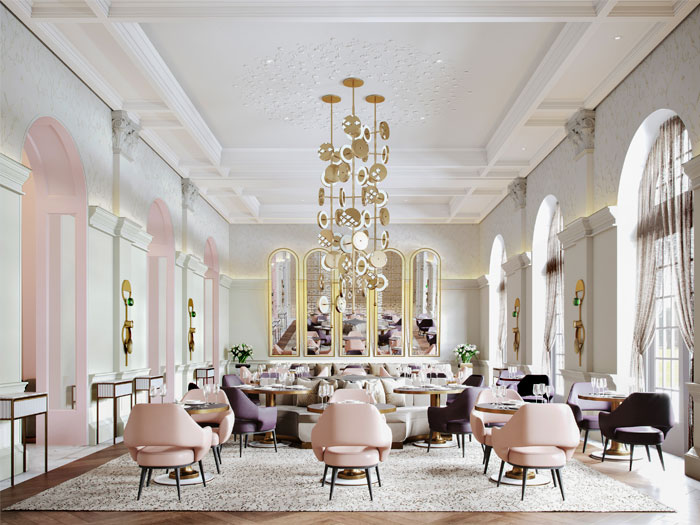
Preciosa adds: “We also created two pieces for La Dame de Pic, a contemporary chic restaurant featuring pastel shades and natural decorative elements such as leather and wood. ‘Pic’ in French is a card game and the team took inspiration from the playing cards used to design a central chandelier and decorative wall.
“The chandelier comprises two pieces of satin brass-covered metal discs decorated in a leaf pattern and LED light strips. The wall features similar leaf décor. Six different metal cube designs were used to construct the wall as well as frosted and mirrored plate glass giving it a contemporary edge.”
Elsewhere in the hotel, a Lasvit chandelier is featured in the Writer’s Bar and In Motion architectural lighting was used to provide the functional aspects of the spaces.
“In general, all decorative lighting fixtures were selected to be part of the decorative elements to enhance the interior design concepts while all architectural lighting fixtures help to provide proper illumination to a space and to highlight focuses of interests; such as flower arrangements and art pieces etc.,” explains Kwan.
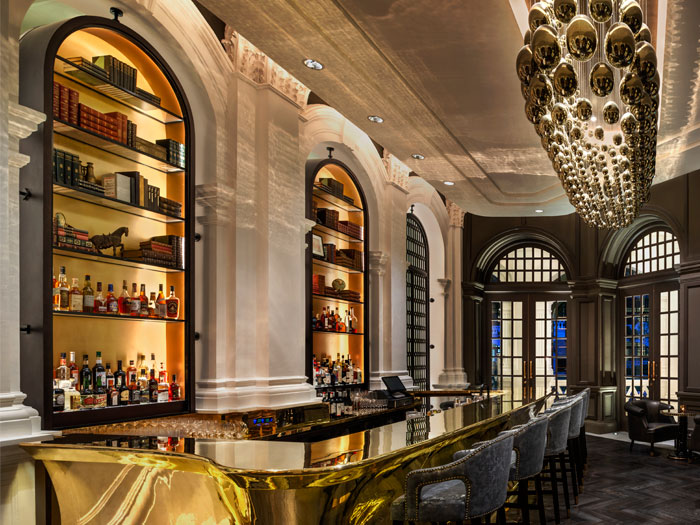
“It was neither possible nor desirable to install burial types of light fittings into the building, hence in many cases, custom housings were designed to conceal lighting fittings, which could be blended into its architecture as the building is over 100 years old.
“All architectural light fittings were chosen by our company based on their technical performance such as lighting outputs, colour temperatures, colour renderings, beam angles, and dimming capabilities, etc. Whereas the interior designer was responsible for choosing all decorative lighting fittings.
“Afterall, this is an existing and a heritage building where there are lots of limitations and constraints as to the installation method of light fittings on to the building externally or internally,” he adds. “Most of the solutions were decided on-site as how the conduits were run and light fittings were installed without damaging the structure of the building.
“The standout lighting features perhaps are the burial uplights to highlight the details of the columns in the lobby, of which such lighting design approach was not possible 100 years ago.”
Overall, the end result of the Raffles’ refurbishment is a beautiful harmonious design that brightens and freshens the traditional building, whilst paying respect to its heritage and historic importance in Singapore and the international hotel community.
Reflecting on the project and the results of their design, Bakos adds: “We didn’t face too many challenges when it came to fulfilling the client's wants and desires. From beginning to end, we were all fairly aligned in our vision for the renovation of the hotel. Everything was designed to work harmoniously with one another.
"We were quite pleased - the project didn’t stray from our initial design concepts. The only thing that changed (and actually for the best) was the inclusion of the La Dame de Pic restaurant in our scope. The restaurant came fairly late in the design process - but it made for a really wonderful addition to the work we did for the client. “Overall the lighting adds a bit of magic and enchantment to the hotel. It gave each room shape and a character of its own.
“We’ve built a reputation for working within iconic and historic hospitality spaces - however with this hotel there was a huge emotional and historical relationship that Raffles has with the country of Singapore and its visitors. It’s a highly visible hotel. We were being trusted to care for and, in some ways, reshape the country’s most precious gem. That’s a huge responsibility! We were so honoured to be hired to do this job. This was a dream project for our team.”
Looking back on his experience working on this iconic project, Kwan reflects with similar sentiments to Bakos: “We are very pleased with the result of the lighting and this includes the client and the design team. The success of the lighting not only gives the hotel a complete fresh look but also brings back the historical nostalgic and its value. All the decorative lighting aspects were carefully selected together with the design team to ensure the lighting output, colour temperatures and effects would provide the ambience most appropriate to each space.
“We are very pleased with the overall result and the working relationships with the clients and design team and there is nothing we could think of to change it for the better.”
www.champalimaud.design
www.tinokwan.com
Asilia Sayari, Tanzania
Asilia Africa opens newly redesigned Sayari Camp in Tanzania with interior design and lighting design Caline Williams-Wynn.
Asilia Africa offer authentic East African safari experiences that leave positive impacts on Africa’s crucial wilderness areas. This summer it opened its redesigned Sayari Camp in Tanzania. The complete rebuild property was timely finished to coincide with the natural phenomenon of the wildebeest crossing of the Mara River. The reopening of Sayari compliments the Highlands in Ngorongoro and the newly redesigned Namiri Plains in the Eastern Serengeti, creating a portfolio of stylish properties by Asilia with a light footprint in the outstanding African destinations.
During the challenging period the world is enduring due to the Covid-19 pandemic, Asilia has managed to keep a circuit of camps open as a testament to its commitment to its employees, local community partners and conservation efforts. This idea of being a conscientious holiday destination is extremely important to Asilia, which is known for pioneering safaris to remote locations where they can have the maximum positive impact. Furthermore, in order to ensure long-term conservation of northern Serengeti, Sayari was the first camp to put down permanent roots in 2009. Typically, an area plagued with bush meat poaching as a result of a lack of other means of livelihood for surrounding communities, the Sayari camp in turn provided employment opportunities for many. The camp is entirely Tanzanian run and of the 55 staff, 80% are from local communities, of which many were former poachers.
“Sayari and Asilia pioneered the tourism driven conservation of this magical region back in the mid-2000s. Through our heavy investment, we are committed and determined to do so again. The recovery of this region is critical for the country, the region and all those who benefit from that,” says Gordie Owles, Commercial Director.
Designer Caline Williams-Wynn, of Cape Town-based Artichoke, was responsible for completing the updated interior schemes for this project. She is the creative master behind other Asilia destinations including the award-winning Highlands in Ngorongoro, Jabali Risge in Ruaha National Park and the recently refurbished Namiri Plains in eastern Serengeti.
“I have been working with Asilia for the last five years, working on interior design and architecture for some of its most exciting properties,” says Williams-Wynn.
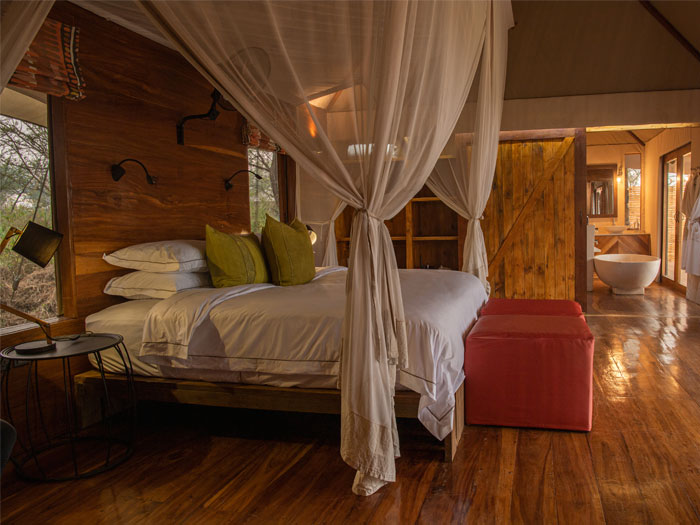
“The initial brief for the reimagining of Sayari Camp was to create different areas that the guests could experience. Increasing the size of the dining room, creating a bar area and to introduce a library and sitting room.”
The project, taking only nine months to complete, consists 15 spacious tents that all boast views of the surrounding rolling plains. Sayari is not a fenced camp, allowing wildlife to move freely throughout. Inside, the colour palettes are inspired by the patterns in the rocks that stud the grass landscape, with a rich copper being a key accent colour.
“Decorative lighting creates the atmosphere and is part of the design element,” explains Williams-Wynn. “Lighting is an art form in my design work and creates a talking piece. Subtle lighting is used over the library shelves, highlighting the stone walls. The decision behind the decorative lighting choices was to bring in all of the colours used in the design and to introducing texture, leather, wire, string and glass. Copper was the metal used in the accent detail and this is visible in the bar lighting and torch lights,” she adds.
Known for sourcing only on the continent and using as much locally produced furniture as possible, Williams-Wynne selected large Leather Urchin pendants for the living room from South African lighting studio Highthorn and Sienna copper wall lights and torch lights from Rebel Lighting. In the bar area, dark brown wicker Lambat hanging lights from Weylandts were used along with warm brown string pendants, also from Highthorn, in the dining room.
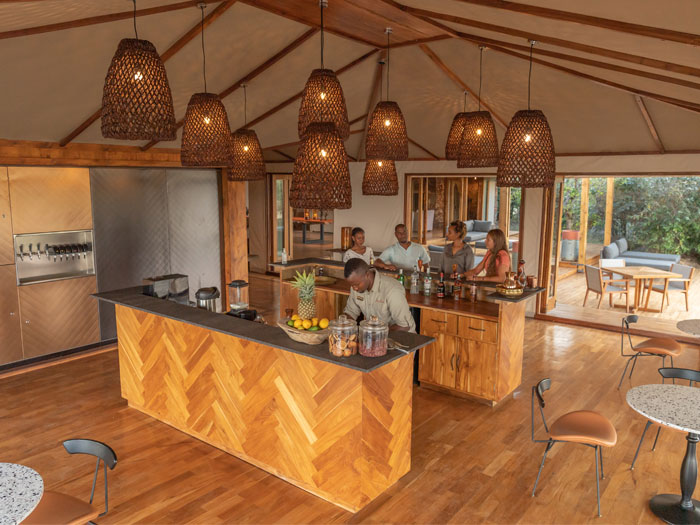
“We had a large volume to use above the ring beams, so oversized feature pendants created a spectacular installation of decorative lighting,” says Williams-Wynn.
“As with all Asilia projects, the design is rooted in the area in which the camp is situated. In the case of Sayari, I took inspiration from the colourful culture of the Kuria people who call the northern Serengeti their home.”
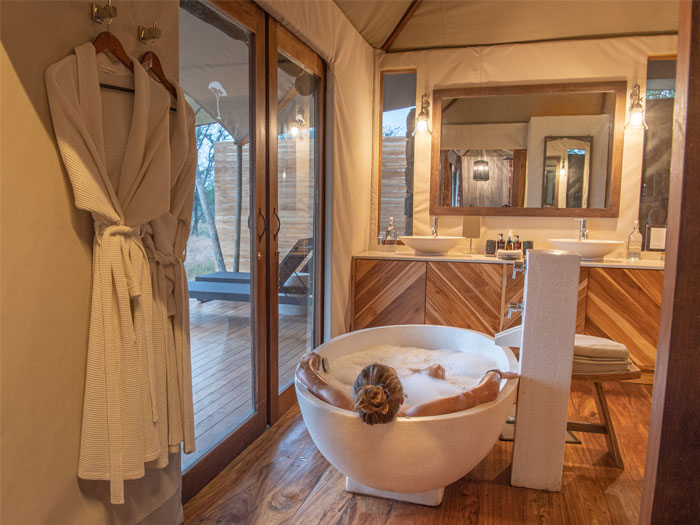
Asilia has been carbon neutral since 2009 and strives to develop practical ways to further reduce its footprint. The new Sayari continues that tradition by introducing the first solar powered microbrewery in the bush in partnership with Scandinavian start-up, Wayout. The brewery uses solar power to create beer and soft drinks on site, as well as purifying water, which removes the need for plastic bottles and cans in the camp. This not only reduces waste, but reduces the transport footprint.
In anticipation of a desire to travel more consciously post-Covid-19, Asilia has been putting time and energy into slowing down the safari experience, encouraging guests to spend longer in each camp and fly less. This is a response to both the desire to slow down but also lower the traveller’s carbon footprint.
Jeroen Hardwerwijk, Co-Founder and Managing Director comments: "Fifteen years ago, when we were choosing a site for Sayari, there were no roads in the area and no airstrip. We slept in our car at the ranger post. Poaching was rife; you can still see the bullet holes in the walls of the ranger post today. Over the past couple of years, when I landed at Kogatende airstrip and saw the fleets of safari cars I was proud to know that we played a pivotal role in creating a conservation economy there. The presence of tourism helped drastically reduce the bush meat poaching, but it was only successful because we worked hand-in-hand with the local communities, creating benefits for them from the new tourism industry. We will continue working hand-in-hand with local communities during this difficult time to support them and I am delighted we are already welcoming our first guests back on safari in Tanzania and Kenya."
www.asiliaafrica.com
rlon - Syntax
 Syntax is the new socket system for s14 tube bulbs by studio rlon. It is designed to be compatible with all kinds of clamps, brackets and other typical mounting points in architecture. This compatibility makes it easy and efficient to create unique lamps and light art installations with tube bulbs in almost any setting.
Syntax is the new socket system for s14 tube bulbs by studio rlon. It is designed to be compatible with all kinds of clamps, brackets and other typical mounting points in architecture. This compatibility makes it easy and efficient to create unique lamps and light art installations with tube bulbs in almost any setting.
Patrizia Garganti - Una

Una lamp is a portable and rechargeable lamp, from Patrizia Garganti, which diffuses light through a crystal element. The lamp is available in varied shapes, each formation specifically chosen to create a charming and unique play of light.
The light crystal lies on a solid metal base that comes in a combination of different satin and polished finishes and it is powered by a lithium battery charged by USB that has an autonomy of up to 12 hours.
SBID Award winners announced

(UK) - The SBID International Design Awards were held online to announce the winners of the 2020 competition.
For the first time in 10 years, the category winners of the SBID International Design Awards were announced publicly online, alongside the inaugural SBID Product Design Awards winners in a joint celebration of interior design excellence.
Despite the unprecedented challenges facing the industry this year, the SBID Awards 2020 have been the most globally represented edition to date. With entries from a staggering 49 countries, the entrants, finalists and winners are a testament to the profession’s extraordinary resilience, demonstrating a world-wide determination to continue to celebrate the achievements of the design profession at large.
Now in its eleventh year, the GOLD-rated awards programme is recognised for its transparency, as well as its professional and ethical standards by The Independent Awards Standards Council. With all categories assessed by panels of leading industry experts who look for outstanding examples of technical content and aesthetic creativity, achieving an SBID Award is an unparalleled marque of industry excellence for the deserving winners.
The Award winners for the interior design categories showcase incredible creative talents from the United Kingdom, Switzerland, United States, Dominican Republic, China, Malaysia, Hong Kong S.A.R., and Canada. With breath-taking interior projects, from multimillion-pound mansions and super luxury private villas to bold, budget-conscious renovations and innovative commercial designs for retail, restaurants, offices and hotels; this year’s designs exemplify the ever increasing standards for the global interior design industry.
Click here to see the full list of winners for Interior Design categories.
From the United Kingdom, Italy, Spain and Denmark, to the United States, Egypt and Taiwan, the Award winners for product design categories highlight some of the world’s the finest examples of intuitive design within the interior sector. Showcasing the inspiring sustainable solutions, quality of craftsmanship, superior performance and inventive functionality which will continue to drive the industry forward through innovation and expertise.
Click here to see the full list of winners for Product Design categories.
In line with its mission to promote and elevate talent and creativity with fairness and equality, the annual event will continue to reward outstanding projects and products as it looks to 2021 with a new optimism for this rapidly evolving industry. One of the most coveted awards is bestowed upon the Overall Winner, presented to the entry that received the highest scores from both tiers of judging and the public votes combined. This year the SBID Awards shines its coveted spotlight on Chinese design studio, Bluemoon Design for its hot-spring-inspired exhibition centre A Hidden Betsuin, using all-natural materials. For product design, leading Italian producer of compound stone, Northstone was awarded this enviable accolade for its artisan tile collection, The Fine Lines by Barbieri.
SBID Founder and CEO, Dr Vanessa Brady OBE comments: “We have all been struggling to cope with the broad effects caused by Covid-19 - as individuals, as well as a community. So the Awards this year, whilst very different, have been particularly inspiring to review. It just goes to prove the importance of our surroundings and how the way we feel and act within them is directly impacted by it. It’s been an important reminder to business owners that good design is not just about its aesthetic and functionality, but particularly in commercial space, it’s also about the intrinsic value great design adds to business.”
Sonneman - A Way of Light launches new products
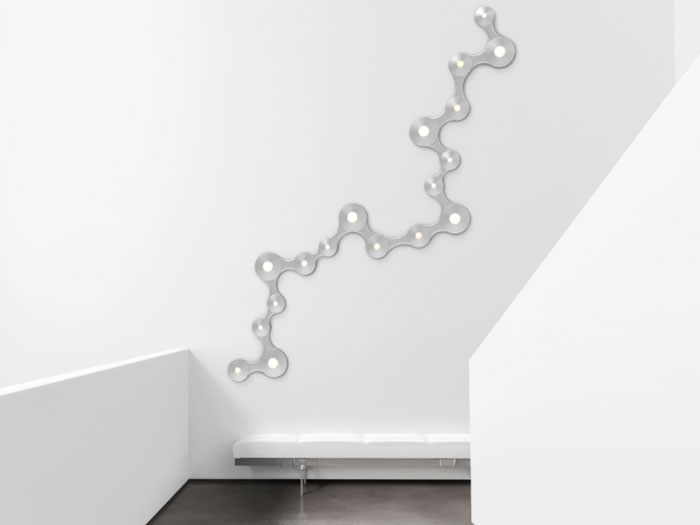
(USA) - Sonneman-A Way Of Light release two new products to the market, expanding on their decorative lighting ranges.
The newest scalable lighting system from Sonneman–A Way of Light is Coral Surface. An expressive and fluid fixture, Coral Surface highlights flowing forms, bringing a soft approach of artistic expression to this expandable system. The metal body connects a series of three-light modules, allowing for configurations of varying size and spacing. Each section features a smooth, circular shade wrapping around the LED source, the diffusers made of thermoplastic with an acrylic lens. As the coral luminaire walks along a ceiling or wall, it creates a useful general glow while also providing more targeted downlighting. The asymmetrical design shows off the organic inspiration of this flush mount, an excellent source of light and style for modern spaces.
Coral Surface is available in bright satin aluminium and satin white finishes, and is offered as a single luminaire, which consists of a connected three-light mounted module, in addition to a three-luminaire configuration, and a six-luminaire configuration. Each individual luminaire is 13.25-inches x 12.25-inches with a depth of 1-inch.
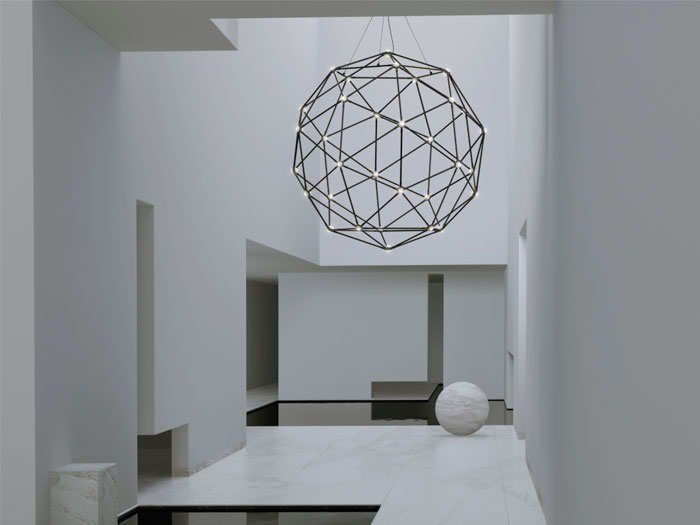
The latest addition to Constellation, a celebrated system of architecturally scalable lighting from Sonneman–A Way of Light, is the Constellation Hedron LED Pendant. It is a spectacular celestial composition of radiant LED hubs connected by the structural tension of minimal coaxial rods that maintain an open design with an air of simplicity. The metal frame forms an angular globe, and is composed of triangles that run throughout the sphere and hold round acrylic shades at the connecting points. The dazzling luminance and expansive scale forms a sculptural connection to the physical properties that define the galaxies of space, occupying a large volume with a low density of mass, as demonstrated by the slender cords that support the robust pendant, creating the appearance of a floating celestial body above a table or display.
The Constellation Hedron LED Pendant is available in satin nickel with white optical acrylic shades or polished black nickel with clear faceted acrylic shades, and is a guaranteed focal point with a height of 45.75-inches and a 45-inch diameter.
In Conversation with Lizette Viloria, Rockwell Group
In this next instalment of [d]arc thoughts, darc magazine’s Acting Editor, Sarah Cullen sits down with Lizette Viloria of design master's Rockwell Group. In this video they discuss the new interior design scheme and incorporation of decorative lighting into Ora, a new space that blends wellness and traditions of ancient tea ceremonies.
Video edited by Sarah Cullen.
Music from bensound.com
LSE Lighting expands pendant range
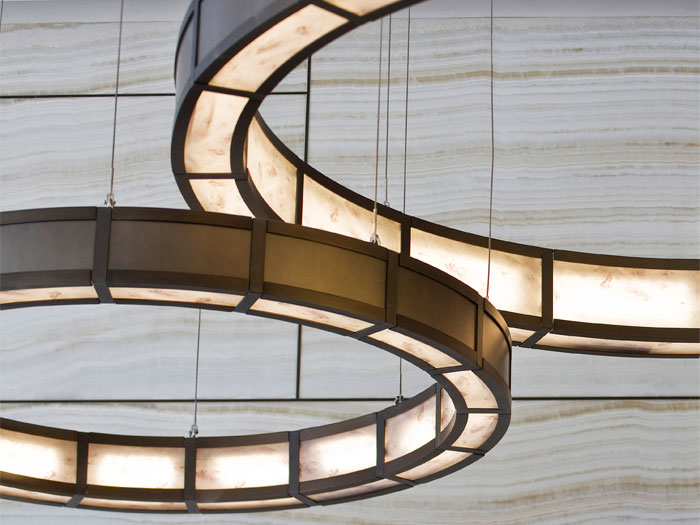
LSE Lighting have expanded its range of bespoke round pendants, offering yet more choice of materials that can be incorporated into the pendants, such as real stone and marble diffusers, and brass, bronze and copper finishes. London and New York are the newest editions to the collection.
